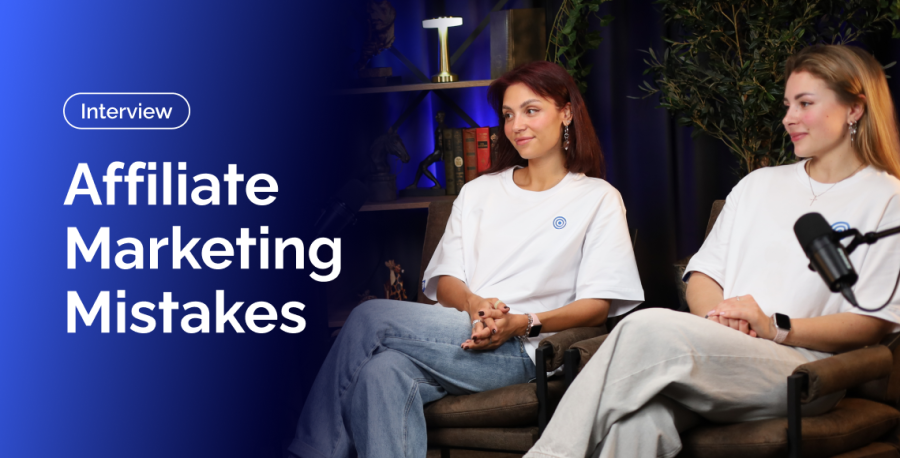Affiliate marketing is an exciting field full of opportunities for growth and success. Yet, like any industry, it comes with common pitfalls that can trip up even experienced media buyers.
To help you navigate these challenges, we sat down with RollerAds account managers, Kate and Mary, to highlight the most frequent mistakes and share strategies to avoid them. This interview is especially valuable for beginners, but seasoned affiliates can gain useful insights too.
Watch the full interview on our YouTube channel or read the transcript below.
Interview with Account Managers
Q: Kate, Mary, thanks for coming! From your perspective, what’s the number one mistake you see over and over again?
Mary: Hi, thanks for having us! Poor targeting, for sure. Lots of affiliates, especially beginners, treat all audiences the same and don’t give targeting the attention it really needs when launching campaigns.
Kate: We recently had a situation where an affiliate launched a campaign without splitting traffic by device. They used the same creatives and flow for both desktop and mobile. Desktop performed fine but mobile drained the budget. After separating devices and optimizing creatives for mobile, ROI improved immediately.
Q: What should affiliates do then? Always reach out to you before launching a campaign?
Mary: In complex cases, yes, affiliates might need help. But for the most part, they can manage on their own by following a few basic recommendations.
Start your first tests with all compulsory targets from the offer, focusing on one GEO and one OS. After collecting data, segment further by OS version, subscription age, interests, and usage patterns to optimize results.
Kate: I’d also suggest sticking to just one or two verticals at a time. If you keep shifting your focus, your results will suffer.
Q: Okay, but if I’m just starting out, which vertical should I first go for?
Kate: Software & Utilities. It’s super popular worldwide, almost everyone has at least one utility app. Plus, it’s full of subniches like VPNs, antiviruses, PDF readers, and many others.
Also, we’ve got case studies and campaign kits on Utilities on our blog. Campaign kits are ready-to-use settings, so you just grab one and launch a campaign using its data.
Q: Yeah, definitely, and we’ll leave the link to our blog under this video. Getting back to our talk. I know that many affiliates neglect tracking, and it might hold back their performance. How important is it to track your campaigns really?
Mary: Yes, there are some affiliates who overlook tracking. But collecting data helps running efficient tests, gathering white- and blacklists, quickly optimizing campaigns without losing your budget and forming a scaling strategy.
Q: I see, tracking is essential, but are there any cases when you don’t need it?
Kate: No, without it you’re flying blind, you can’t measure performance, optimize campaigns, or scale. Even for small tests, tracking gives insights that save time and budget.
Mary: By the way, we recently did a case study to see which bid model works best for test campaigns. Spoiler: it’s better to start with Smart Bidding or CPA Goal. And without tracking, tests are impossible—you can’t really spot and cut out weak zones or creatives, and you also miss the chance to fine-tune bids for scaling.
Kate: Yes, and incorrect bidding is another big mistake. Bidding too low limits ad impressions, while bidding too high can waste budget.
Q: That begs another question: how to find out the right bids?
Kate: First, you can always rely on our team for guidance. Second, in the campaign settings, you’ll see bid recommendations based on real data. And of course, using our SmartCPC or SmartCPM helps optimize spending automatically and gives you a solid base for later scaling.
Q: Thanks. Mary, you mentioned the case study about bid models. I already understand why you need to start with smart bidding. What about CPA Goal? How does it work and how is it supposed to help?
Mary: Right, you should start testing with smart models, since they adjust your bids in real time to match the auction price. CPA Goal goes a step further; it doesn’t just optimize bids, but also fine-tunes them for new zones that are likely to convert and skips the ones that don’t perform, so it helps you stay within your target cost per acquisition. Both models protect you from overpaying. On top of that, they let you build white- and blacklists of zones, creatives, OS versions, and more, so you can fine-tune performance and boost ROI.
Q: I see, to round that out, entrust your tests to smart bidding and CPA Goal. Okay, I have another question. When you’re just starting out, and even when you’re an expert running your thousandth campaign, you still need tips on optimizing, launching, bidding, and many other aspects. How do you cope with this surge of requests?
Kate: We find time for every client. And if your manager can’t respond right away (which happens), our support team is always on the line. Here’s another problem: many affiliates neglect their manager’s help and that’s a big missed opportunity. – общий кадр
My recommendation is to stay in close touch with your manager to keep up with trends and avoid mistakes. Don’t hesitate to discuss ideas and strategies—together we can fine-tune your campaigns for stronger ROI and scale. The more you communicate, the faster you’ll get consistent, profitable results.
Q: Copy that. And what are the most common requests your clients come to you for?
Mary: Most of the time, clients ask about the best way to set up their campaigns and what white- or blacklists work well for their vertical in a specific GEO. We can guide you on how to run your campaigns effectively, but there’s no 100% formula—everything is individual, and your funnels, landings, and creatives determine the results. We also share up-to-date bid recommendations and double-check the settings of campaigns that are already running. That way, we can catch mistakes early and save our clients from wasting their budget.
Qa: It seems like your team provides a lot of hands-on support. Do you help clients with creatives? What mistakes should they avoid in this area?
Kate: Yeah, sure, we help with every part of the workflow. We even have an in-platform Creatives library with top-performing creatives with the highest CTR across all verticals and also Autocreatives for Software & Utilities.
One common mistake we see here is to think 1-2 creatives for a campaign will be enough. But that approach hardly ever works. You need to test and refresh creatives, otherwise campaigns burn out fast and results drop.
Mary: Exactly. And it’s not only about quantity, quality matters too. Sometimes affiliates rush and use low-quality images or copy, and that kills CTR from the start. Fresh and relevant creatives can double or triple campaign performance.
Kate: Another mistake we often see is when affiliates don’t fully understand the offer or the registration flow. As a result, they make irrelevant creatives or pre-landers, and conversion rates can drop.
Q: How do you fix that?
Mary: The fix is simple—always study the offer and go through the full flow yourself before launching. That way, your creatives and landing pages stay aligned with the user journey.
Q: Makes perfect sense. Thank you both for taking the time to share all of those insights—I’m sure they will help everyone run more profitable campaigns.
Mary: Thank you, buy.
Kate: Good luck with your campaigns!
Closing Words
Our top priority is to help you succeed quickly and get the most out of your campaigns. If you’re struggling with launching, unsure where to start your tests, or have any other questions about the affiliate marketing process, reach out to us via the in-platform chat. We’re always here to provide the guidance and information you need.
Want a video on a specific topic? Do just the same—contact our support team, and they’ll pass your request to the right people. Let’s make affiliate marketing easier and more accessible together!






